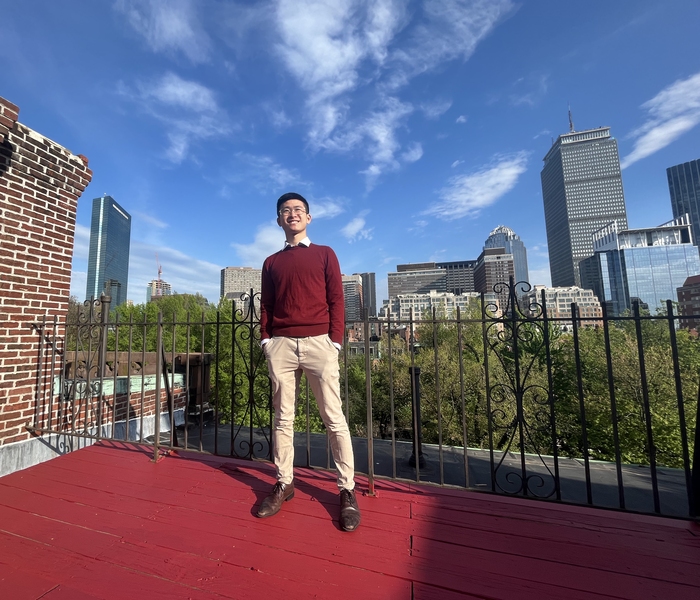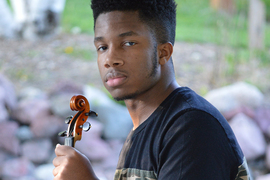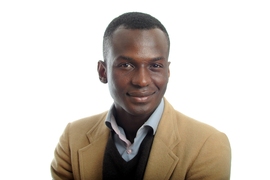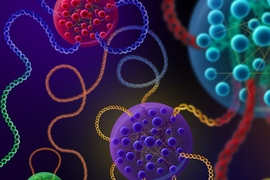Since he was young, Chih-Wei Joshua Liu ’22 always knew he wanted to be a “physician-scientist,” pursuing research at the intersection of basic science and medicine.
“Growing up, I wanted to do work that concretely helps people,” says Liu. “I also wanted to further our understanding of the universe. Physics describes how nature behaves. From equations, we can derive behavior. In biology and medicine, this behavior is extremely complex. I’ve always wondered how these sciences combine: If we can put nature’s beautiful complexity in the language of mathematics, then the world makes sense.”
As the son of a physician / computational biologist, he was exposed early on to a life in research. His family moved from Taipei to Dallas, Texas, and the San Francisco Bay Area before returning to Taiwan during his high school years, when his father joined the faculty at Taiwan’s National Health Research Institutes.
He competed in the Biology Olympiad while at the National Experimental High School, an international school run by the Taiwanese government for foreign-raised children of Hsinchu Science Park employees. Hsinchu Science Park centers on Taiwan Semiconductor Manufacturing Company, which was founded by MIT Corporation board member Morris Chang ’52, SM ’53, ME ’55.
“People at my high school think of MIT as a place where you can make a difference in the world,” Liu says. Drawn to the Institute, both Liu and his twin brother, Chih-Lun Julian, applied to MIT. His brother was then more interested in computational linguistics, while he was drawn to biochemistry and computational biology.
“Much of the most important research in condensates has been at MIT,” he says. “I started going to a biomolecular condensate journal club in my first semester as a freshman and realized that, to really understand condensates, I needed statistical thermodynamics. I was disappointed to learn I couldn’t get very far without physics.”
Having struggled with high school physics, he was apprehensive about the Institute's physics General Institute Requirements (GIRs). “When I took 8.01 with Professor Kiyoshi Masui, I realized that MIT physics — especially the world-famous TEAL [Technology-Enhanced Active Learning] format used for 8.01 and 8.02 — is quite different from multiple-choice AP physics.”
With a strong grasp of Newtonian mechanics, he pushed himself to take the more challenging follow-up class, 8.022 (Physics II: Electricity and Magnetism). From there, he surprised himself by declaring his major as physics.
“The physics GIRs pushed me to branch out academically. I TA'd 8.01 my sophomore year and enjoyed helping other students develop skills and interests in physics.”
He shifted away from biomolecular condensates and pursued research in other areas of biophysics, beginning with work on an experimental evolution approach to engineering microbiome therapeutics with Professor Jeff Gore.
“A long-standing goal in medicine is the ability to tailor microbes to patients’ specific metabolic needs; outside microbes with potentially useful functions don’t usually survive when inserted into patients’ microbiomes,” he says. “We evolved bacteria isolated from the human gut to degrade the compound that causes kidney stones. I found this project exciting because we used mathematical modeling to control the evolutionary trajectory of bacteria in the lab, as well as to engineer something that could have real medical applications.”
In 2020, he began working with Professor Nikta Fakhri on machine-learning approaches for measuring entropy production in biological systems.
“Physicists believe time irreversibility is a key property of life; biological processes irrevocably increase the entropy of the universe,” he says. “However, it’s difficult to actually measure irreversibility. We are using a new machine-learning algorithm to do exactly this. Rho GTPases are a conserved cell-division regulator in almost all animals, including humans and the starfish we use experimentally. Using our neural network, we have quantitatively measured the arrow of time in this crucial biological system; Rho is implicated in cancer, among other diseases.”
He presented this work at the March Meeting of the American Physical Society, and plans to soon submit a joint first-author manuscript for review.
Supporting mental wellness
“I know a lot of people who have struggled with mental health issues,” he says. “MIT is a pretty stressful place, and a lot of people struggle when they get here. This is an issue I really wanted to get involved in.”
This drew him to the pressing problems of mental health on and off campus.
During the pandemic, he joined the MIT Wellbeing Ambassadors to distribute Covid-19 guidelines and personal protective equipment to students remaining on campus during the pandemic. As president of Active Minds and Peer Ears, he led the merger of MIT’s two mental-wellness peer-education groups, and worked with MIT’s Office of Student Wellbeing and clinicians at Student Mental Health and Counseling Services to provide undergraduate students and organizations with active listening training.
Last summer, as a PKG Social Impact Intern at the Massachusetts General Hospital (MGH) Department of Psychiatry, he used instant smartphone surveys to track time use in people with schizophrenia-spectrum and bipolar-spectrum disorders. By analyzing the data, he saw the emergence of the effects of race and socioeconomic status on functioning in people with severe mental illnesses, which he is writing about for the journal Clinical Psychological Science.
“I hope my work will help future psychiatrists address racial and socioeconomic inequities in caring for people with severe mental illnesses,” he says.
In his second project for MGH, he used instant smartphone surveys to track hallucinations and metacognitive processes in people with schizophrenia. “Analyzing this data, we were able to substantiate a connection between metacognitive errors and hallucinations in people with schizophrenia,” he says. That manuscript will be submitted in June.
For his own method of stress release, in his first year he shared his love of post-hardcore punk rock with a 2 a.m. show on WMBR, until he realized it didn’t work with his schedule. He is president of MIT’s Society of Physics Students, which organizes events for Course 8 undergraduates such as study breaks, movie nights, and the annual PRISM research conference. He has served on the Physics Values Committee, a departmental committee of faculty, staff, and students working together to improve underrepresented-student recruitment to MIT physics, and to support more inclusive faculty advising.
He was also community service chair and associate member educator at his fraternity, Phi Kappa Theta. As community service chair, he sourced 12,000 face masks from the Taiwanese government during the 2020 U.S. mask shortage and organized a fundraiser to purchase these masks and donate them to Beth Israel Deaconess Medical Center. “It has been one of my defining experiences at MIT,” he says.
Liu is also an avid hiker and likes to visit area tide pools to study marine invertebrates.
Next stop: Research and MD-PhD
He is applying to MD-PhD programs to pursue research at the intersection of biostatistics and statistical mechanics. In the meantime, he will continue his research in Fakhri’s group, studying recently identified “non-reciprocal” phases of matter in drug-resistant bacteria.
As a future physician-physicist, Liu hopes to apply the mathematical techniques he picked up in his physics classes to help those struggling with mental health issues.
“I hope to apply fundamental physics to the pressing problems of human health,” he says. “Non-equilibrium thermodynamics has recently proven its potential in fundamental biology. I believe the same theoretical framework might be just as insightful in translational medicine.”









